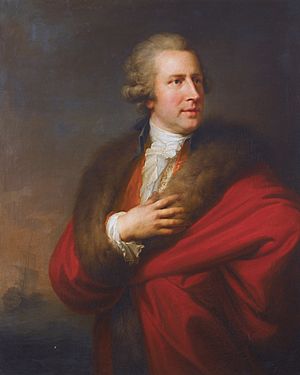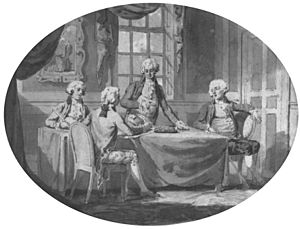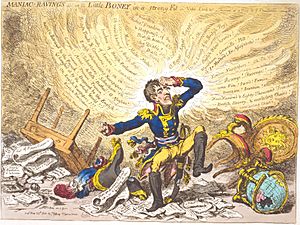Charles Whitworth, 1st Earl Whitworth facts for kids
Quick facts for kids
The Earl Whitworth
|
|
|---|---|

Charles Whitworth (1752-1825), by Johann Baptist von Lampi the Elder
|
|
| Lord Lieutenant of Ireland | |
| In office 23 June 1813 – 3 October 1817 |
|
| Monarch | George III |
| Preceded by | The Duke of Richmond |
| Succeeded by | The Earl Talbot |
Charles Whitworth, 1st Earl Whitworth (born May 29, 1752 – died May 13, 1825) was an important British diplomat and politician. He was known by different titles during his life, including Lord Whitworth and Viscount Whitworth. He played a key role in British relations with other European countries, especially during the time of Napoleon Bonaparte.
Contents
Early Life and First Steps in Diplomacy
From Soldier to Diplomat
Charles Whitworth was born in Kent, England, in 1752. He was the oldest of three sons. He went to Tonbridge School for his education.
He started his career in the military in 1772. He became a captain in 1781. By 1783, he was a lieutenant-colonel. However, he soon moved from being a soldier to working in diplomacy.
Early Diplomatic Missions
In 1785, Whitworth became a special envoy to Poland. At that time, Stanisław Poniatowski was the king. Whitworth was in Warsaw during a difficult period before Poland was divided by other countries.
After Poland, he was sent to St. Petersburg, Russia, in 1788. He stayed there for almost 12 years. This was a very important time in his career.
Working as an Ambassador in Russia
Building Relations with Catherine the Great
In Russia, Whitworth was welcomed by Catherine the Great. At first, things were good between Britain and Russia. But then, Britain's Prime Minister, William Pitt, wanted to stop Russia from expanding its power. He thought Russia was disturbing the "balance of power" in Europe.
Britain wanted Russia to give back some land it had taken from Turkey. Russia refused. This caused tension, and there was talk of war. Whitworth warned that Russia was very determined.
Dealing with Difficult Times
In 1791, Pitt's plans faced opposition in Britain. So, Britain changed its demands. This made relations with Russia difficult for a while. Catherine the Great even made a sarcastic comment to Whitworth about Britain trying to "drive her out of Petersburg."
However, things slowly improved. Both Russia and Britain became worried about the French Revolution. This shared concern brought them closer. In 1795, Catherine agreed to send many soldiers to help fight against France. This was a big success for Whitworth's diplomacy.
Alliance and Dismissal
When Paul I became Czar, he initially refused to sign the treaty. But later, he became angry with France. This was because France attacked the Knights of St. John in Malta, whom Paul protected.
Whitworth convinced Paul to form an alliance with Britain in 1798. This alliance helped lead to military operations against France in Italy. Whitworth was very popular in St. Petersburg. Paul I even asked the British government to make him a noble.
In 1800, Whitworth was made Baron Whitworth. But soon after, Paul I made peace with Napoleon. He also became angry that Britain kept Malta. So, Paul suddenly dismissed Whitworth. This led to more conflicts between Russia and Britain.
A Quick Stop in Denmark
In July 1800, Britain had a problem with Denmark. A British ship stopped a Danish ship, which caused tension. To prevent a fight, the British government sent Whitworth on a special mission to Copenhagen.
He arrived with a strong British naval fleet to support his talks. Denmark's defenses were not ready, so Whitworth's arguments worked. He returned to England in September 1800.
Marriage and Wealth
In 1801, Whitworth married the Duchess Arabella Diana. She was the widow of his old friend, the Duke of Dorset. The Duchess was a wealthy woman. She owned a large amount of money and property, including Knole Park. This marriage greatly increased Whitworth's own wealth.
Ambassador to France
A New Role in Paris
After the Treaty of Amiens was signed in 1802, Whitworth was chosen to be the British ambassador in Paris. This was a very important job. He arrived in France with a large group of people and was welcomed with excitement. It had been a long time since a British ambassador had been in France.
He met Napoleon Bonaparte and his wife, Joséphine, in December 1802. At first, things seemed calm. Napoleon ignored British newspaper attacks, and Britain kept quiet about France's actions in other parts of Europe.
Growing Tensions with Napoleon
The main problem was Malta. Britain refused to leave Malta until other countries guaranteed its safety for the Knights of St. John. This issue was first brought up by the French foreign minister, Talleyrand, in January 1803.
Soon after, a report was published in France that criticized Britain. This made Britain believe France was planning to invade Egypt again. So, Britain told Whitworth to stand firm on keeping Malta.
On February 18, Napoleon met Whitworth. Napoleon was very angry and spoke loudly. He suggested that France and Britain should unite instead of fighting. But he also called Britain's concerns "bagatelles," meaning trivial things.
The most famous meeting happened on March 13, 1803, at the Tuileries Palace. Napoleon had a violent outburst in front of many people. He shouted at Whitworth, saying, "Woe to those who do not respect treaties! They will be responsible to all Europe." Whitworth remained calm and did not reply. Many people present were shocked by Napoleon's behavior.
This meeting was not the very last one. Whitworth met Napoleon again in April. But by May 12, Whitworth asked for his travel documents. On May 18, Britain declared war on France. Whitworth returned to London, having shown great dignity during these difficult talks.
Later Life and Honors
After returning from France, Whitworth was less involved in public life for ten years. In 1809, he became a Lieutenant-Colonel in the local militia.
In 1813, he was appointed Lord Lieutenant of Ireland, a very important role. He held this position until 1817. In the same year, he was made an English noble, becoming Viscount Whitworth.
He received further honors in 1815, becoming a Grand Cross of the Bath and then Earl Whitworth. After the Bourbon family returned to power in France, he visited Paris in 1819. He also traveled to Naples.
Lord Whitworth's last public appearance was at the coronation of King George IV in 1821.
Death
Lord Whitworth passed away on May 13, 1825, at Knole Park. He had no children, so all his titles ended with him. His wife, the Duchess of Dorset, died shortly after him.
Likenesses
Charles Whitworth was considered a very handsome man. A famous portrait of him was painted by Sir Thomas Lawrence. An engraving of this portrait can be found in books about British nobility. This original painting is now in the Louvre museum in Paris.
Images for kids
-
In Maniac-Ravings—or—Little Boney in a strong Fit (1803), James Gillray caricatured Napoleon's tirade to Whitworth at the Tuileries on 13 March 1803.





